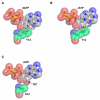Unlocking the sugar "steric gate" of DNA polymerases
- PMID: 21226515
- PMCID: PMC3040255
- DOI: 10.1021/bi101915z
Unlocking the sugar "steric gate" of DNA polymerases
Abstract
To maintain genomic stability, ribonucleotide incorporation during DNA synthesis is controlled predominantly at the DNA polymerase level. A steric clash between the 2'-hydroxyl of an incoming ribonucleotide and a bulky active site residue, known as the "steric gate", establishes an effective mechanism for most DNA polymerases to selectively insert deoxyribonucleotides. Recent kinetic, structural, and in vivo studies have illuminated novel features about ribonucleotide exclusion and the mechanistic consequences of ribonucleotide misincorporation on downstream events, such as the bypass of a ribonucleotide in a DNA template and the subsequent extension of the DNA lesion bypass product. These important findings are summarized in this review.
Figures




References
-
- Ohmori H, Friedberg EC, Fuchs RP, Goodman MF, Hanaoka F, Hinkle D, Kunkel TA, Lawrence CW, Livneh Z, Nohmi T, et al. The Y-family of DNA polymerases. Mol Cell. 2001;8:7–8. - PubMed
-
- Fowler JD, Suo Z. Biochemical, structural, and physiological characterization of terminal deoxynucleotidyl transferase. Chem Rev. 2006;106:2092–2110. - PubMed
-
- Steitz TA. DNA polymerases: structural diversity and common mechanisms. J Biol Chem. 1999;274:17395–17398. - PubMed
Publication types
MeSH terms
Substances
Grants and funding
LinkOut - more resources
Full Text Sources
Other Literature Sources

